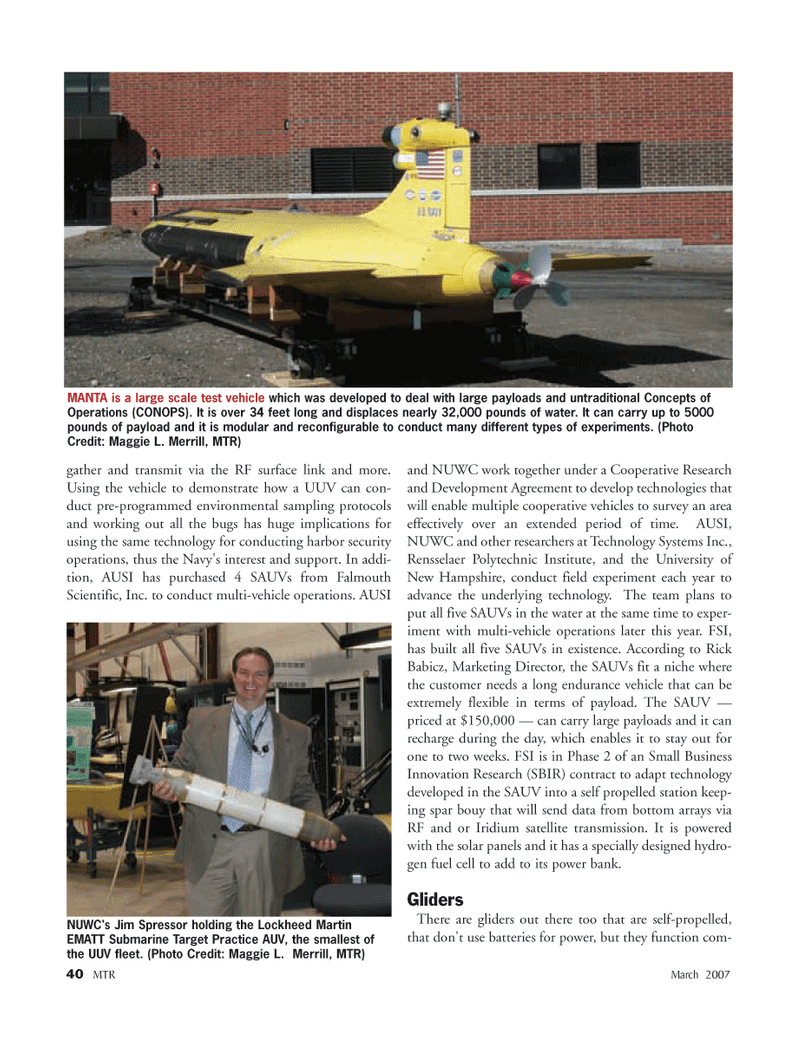
Page 40: of Marine Technology Magazine (March 2007)
AUVs, ROVs, UUVs
Read this page in Pdf, Flash or Html5 edition of March 2007 Marine Technology Magazine
gather and transmit via the RF surface link and more.
Using the vehicle to demonstrate how a UUV can con- duct pre-programmed environmental sampling protocols and working out all the bugs has huge implications for using the same technology for conducting harbor security operations, thus the Navy's interest and support. In addi- tion, AUSI has purchased 4 SAUVs from Falmouth
Scientific, Inc. to conduct multi-vehicle operations. AUSI and NUWC work together under a Cooperative Research and Development Agreement to develop technologies that will enable multiple cooperative vehicles to survey an area effectively over an extended period of time. AUSI,
NUWC and other researchers at Technology Systems Inc.,
Rensselaer Polytechnic Institute, and the University of
New Hampshire, conduct field experiment each year to advance the underlying technology. The team plans to put all five SAUVs in the water at the same time to exper- iment with multi-vehicle operations later this year. FSI, has built all five SAUVs in existence. According to Rick
Babicz, Marketing Director, the SAUVs fit a niche where the customer needs a long endurance vehicle that can be extremely flexible in terms of payload. The SAUV — priced at $150,000 — can carry large payloads and it can recharge during the day, which enables it to stay out for one to two weeks. FSI is in Phase 2 of an Small Business
Innovation Research (SBIR) contract to adapt technology developed in the SAUV into a self propelled station keep- ing spar bouy that will send data from bottom arrays via
RF and or Iridium satellite transmission. It is powered with the solar panels and it has a specially designed hydro- gen fuel cell to add to its power bank.
Gliders
There are gliders out there too that are self-propelled, that don't use batteries for power, but they function com- 40 MTR March 2007
MANTA is a large scale test vehicle which was developed to deal with large payloads and untraditional Concepts of
Operations (CONOPS). It is over 34 feet long and displaces nearly 32,000 pounds of water. It can carry up to 5000 pounds of payload and it is modular and reconfigurable to conduct many different types of experiments. (Photo
Credit: Maggie L. Merrill, MTR)
NUWC's Jim Spressor holding the Lockheed Martin
EMATT Submarine Target Practice AUV, the smallest of the UUV fleet. (Photo Credit: Maggie L. Merrill, MTR)
MTR#2 (33-48).qxd 3/2/2007 11:19 AM Page 40

 39
39

 41
41
